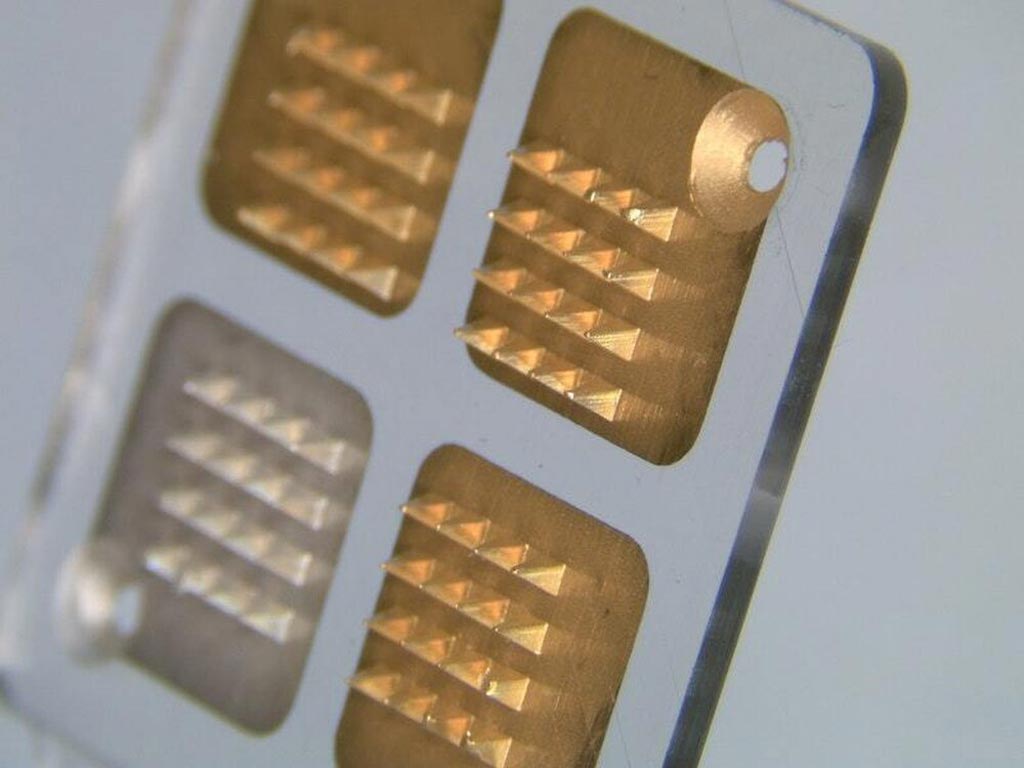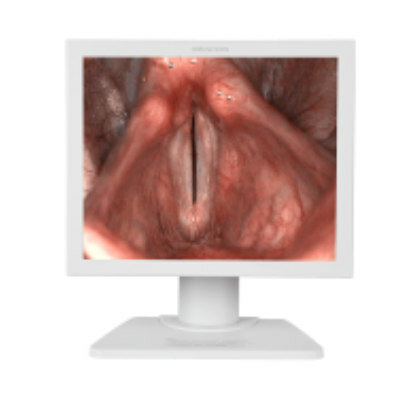Microneedle Biosensors Monitor Changing Antibiotic Concentrations
|
By HospiMedica International staff writers Posted on 08 Oct 2019 |

Image: A new study shows how microneedle biosensors can detect antibiotic levels in real time (Photo courtesy of Imperial).
A new study shows how small, non-invasive biosensor patches can accurately detect antibiotic levels in a patient's system, matching the accuracy of current clinical methods.
Developed at Imperial College London (Imperial; United Kingdom), Swansea University (United Kingdom), and Hammersmith Hospital (London, United Kingdom), the biosensors are made of solid microscopic lancets that penetrate the skin. The lancets, which act as electrodes, detect pH changes in interstitial fluid. They can also be coated with enzymes that react with a drug of choice, altering the local pH of the surrounding tissue if the drug is present. For the study, they were coated with a β-lactam enzyme.
In a small proof-of-concept trial, the sensors were tested in 10 healthy patients. The biosensor patches were placed on the forearm, with measurements taken from 30 minutes before receiving oral penicillin, to four hours afterwards. Blood samples were taken at the same time points for comparison. The data revealed that while penicillin concentrations varied widely from patient to patient, the overall readings from the biosensors were similar to those from the blood samples, showing a marked decrease in drug concentration over time. The limit of detection was estimated at 0.17 mg/L. The study was published on September 30, 2019, in The Lancet Digital Health.
“When patients in hospital are treated for severe bacterial infections the only way we have of seeing whether antibiotics we give them are working is to wait and see how they respond, and to take frequent blood samples to analyze levels of the drugs in their system, but this can take time,” said lead author Timothy Rawson, PhD, of the Imperial. “Our biosensors could help to change that. By using a simple patch on the skin of the arm, or potentially at the site of infection, it could tell us how much of a drug is being used by the body and provide us with vital medical information, in real time.”
“Technological solutions such as our microneedle biosensor could prove crucial in improving how we use and protect the arsenal of life-saving antibiotics we have available to treat patients,” said senior author Professor Alison Holmes, MD, of the Imperial. “Ultimately, these types of collaborative, multidisciplinary solutions could lead to earlier detection and better treatment of infections, helping to save more lives and protect these invaluable medicines for generations to come.”
Penicillin, discovered in 1928 by Scottish scientist Alexander Fleming, is a β-lactam antibiotic effective against many bacterial infections caused by staphylococci and streptococci.
Related Links:
Imperial College London
Swansea University
Hammersmith Hospital
Developed at Imperial College London (Imperial; United Kingdom), Swansea University (United Kingdom), and Hammersmith Hospital (London, United Kingdom), the biosensors are made of solid microscopic lancets that penetrate the skin. The lancets, which act as electrodes, detect pH changes in interstitial fluid. They can also be coated with enzymes that react with a drug of choice, altering the local pH of the surrounding tissue if the drug is present. For the study, they were coated with a β-lactam enzyme.
In a small proof-of-concept trial, the sensors were tested in 10 healthy patients. The biosensor patches were placed on the forearm, with measurements taken from 30 minutes before receiving oral penicillin, to four hours afterwards. Blood samples were taken at the same time points for comparison. The data revealed that while penicillin concentrations varied widely from patient to patient, the overall readings from the biosensors were similar to those from the blood samples, showing a marked decrease in drug concentration over time. The limit of detection was estimated at 0.17 mg/L. The study was published on September 30, 2019, in The Lancet Digital Health.
“When patients in hospital are treated for severe bacterial infections the only way we have of seeing whether antibiotics we give them are working is to wait and see how they respond, and to take frequent blood samples to analyze levels of the drugs in their system, but this can take time,” said lead author Timothy Rawson, PhD, of the Imperial. “Our biosensors could help to change that. By using a simple patch on the skin of the arm, or potentially at the site of infection, it could tell us how much of a drug is being used by the body and provide us with vital medical information, in real time.”
“Technological solutions such as our microneedle biosensor could prove crucial in improving how we use and protect the arsenal of life-saving antibiotics we have available to treat patients,” said senior author Professor Alison Holmes, MD, of the Imperial. “Ultimately, these types of collaborative, multidisciplinary solutions could lead to earlier detection and better treatment of infections, helping to save more lives and protect these invaluable medicines for generations to come.”
Penicillin, discovered in 1928 by Scottish scientist Alexander Fleming, is a β-lactam antibiotic effective against many bacterial infections caused by staphylococci and streptococci.
Related Links:
Imperial College London
Swansea University
Hammersmith Hospital
Latest Critical Care News
- Ingestible Capsule Monitors Intestinal Inflammation
- Wireless Implantable Sensor Enables Continuous Endoleak Monitoring
- Pulse Oximeter Index Offers Non-Invasive Guides for Fluid Therapy
- Wearable Patch for Early Skin Cancer Detection to Reduce Unnecessary Biopsies
- 'Universal' Kidney to Match Any Blood Type
- Light-Based Technology to Measure Brain Blood Flow Could Diagnose Stroke and TBI
- AI Heart Attack Risk Assessment Tool Outperforms Existing Methods
- Smartphone Imaging System Enables Early Oral Cancer Detection
- Swallowable Pill-Sized Bioprinter Treats GI Tract Injuries

- Personalized Brain “Pacemakers” Could Help Patients with Hard-To-Treat Epilepsy
- Microscopic DNA Flower Robots to Enable Precision Medicine Delivery
- Origami Robots to Deliver Medicine Less Invasively and More Effectively
- Improved Cough-Detection Technology Aids Health Monitoring
- AI Identifies Children in ER Likely to Develop Sepsis Within 48 Hours
- New Radiofrequency Therapy Slows Glioblastoma Growth
- Battery-Free Wireless Multi-Sensing Platform Revolutionizes Pressure Injury Detection
Channels
Surgical Techniques
view channel
Robotic Assistant Delivers Ultra-Precision Injections with Rapid Setup Times
Age-related macular degeneration (AMD) is a leading cause of blindness worldwide, affecting nearly 200 million people, a figure expected to rise to 280 million by 2040. Current treatment involves doctors... Read more
Minimally Invasive Endoscopic Surgery Improves Severe Stroke Outcomes
Intracerebral hemorrhage, a type of stroke caused by bleeding deep within the brain, remains one of the most challenging neurological emergencies to treat. Accounting for about 15% of all strokes, it carries... Read morePatient Care
view channel
Revolutionary Automatic IV-Line Flushing Device to Enhance Infusion Care
More than 80% of in-hospital patients receive intravenous (IV) therapy. Every dose of IV medicine delivered in a small volume (<250 mL) infusion bag should be followed by subsequent flushing to ensure... Read more
VR Training Tool Combats Contamination of Portable Medical Equipment
Healthcare-associated infections (HAIs) impact one in every 31 patients, cause nearly 100,000 deaths each year, and cost USD 28.4 billion in direct medical expenses. Notably, up to 75% of these infections... Read more
Portable Biosensor Platform to Reduce Hospital-Acquired Infections
Approximately 4 million patients in the European Union acquire healthcare-associated infections (HAIs) or nosocomial infections each year, with around 37,000 deaths directly resulting from these infections,... Read moreFirst-Of-Its-Kind Portable Germicidal Light Technology Disinfects High-Touch Clinical Surfaces in Seconds
Reducing healthcare-acquired infections (HAIs) remains a pressing issue within global healthcare systems. In the United States alone, 1.7 million patients contract HAIs annually, leading to approximately... Read moreHealth IT
view channel
Printable Molecule-Selective Nanoparticles Enable Mass Production of Wearable Biosensors
The future of medicine is likely to focus on the personalization of healthcare—understanding exactly what an individual requires and delivering the appropriate combination of nutrients, metabolites, and... Read moreBusiness
view channel
Philips and Masimo Partner to Advance Patient Monitoring Measurement Technologies
Royal Philips (Amsterdam, Netherlands) and Masimo (Irvine, California, USA) have renewed their multi-year strategic collaboration, combining Philips’ expertise in patient monitoring with Masimo’s noninvasive... Read more
B. Braun Acquires Digital Microsurgery Company True Digital Surgery
The high-end microsurgery market in neurosurgery, spine, and ENT is undergoing a significant transformation. Traditional analog microscopes are giving way to digital exoscopes, which provide improved visualization,... Read more
CMEF 2025 to Promote Holistic and High-Quality Development of Medical and Health Industry
The 92nd China International Medical Equipment Fair (CMEF 2025) Autumn Exhibition is scheduled to be held from September 26 to 29 at the China Import and Export Fair Complex (Canton Fair Complex) in Guangzhou.... Read more













